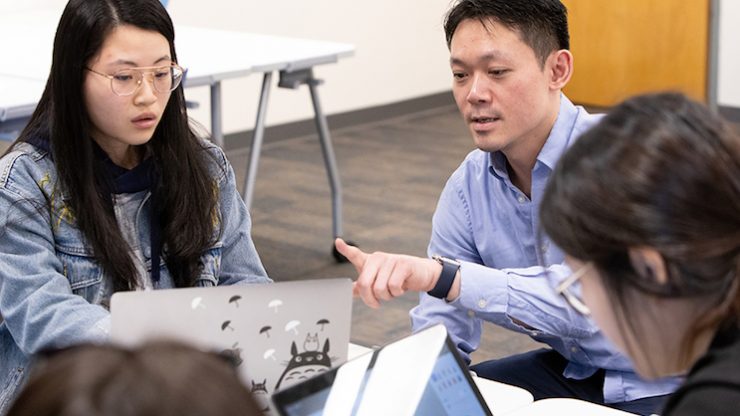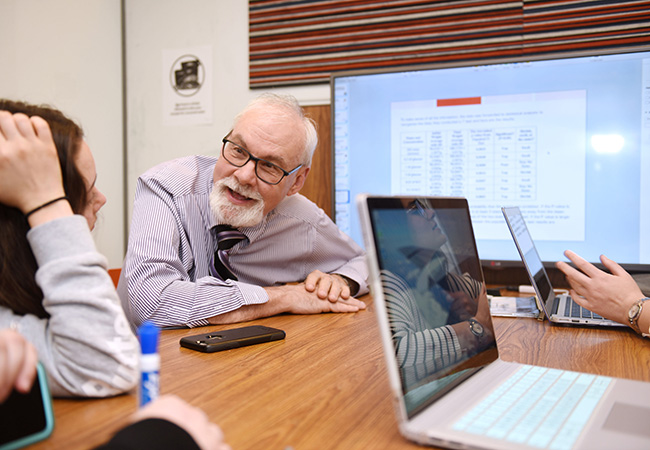
Two professors find new ways of engaging students. Thanks to recent breakthroughs in the science of education, the college classroom is at the center of a pedagogical revolution.
Two professors find new ways of engaging students.
Thanks to recent breakthroughs in the science of education, the college classroom is at the center of a pedagogical revolution. Old models that emphasize traditional teaching are being supplemented with new ones that incorporate the growing body of evidence supporting experiential learning. Instead of attending lectures, students can design and perform their own lab experiments or go out into the field to see how theoretical concepts apply in the real world. Experiential learning courses not only promote student engagement, but also better prepare students to put what they learn to practical use when they leave school.
Adelphi students are already experiencing the power of this novel approach. David Parkin, PhD, associate professor of chemistry, and Chia Yuan Hung, EdD, associate professor in the Ruth S. Ammon School of Education, have developed new pedagogical techniques to promote learning. Their students may be encouraged to work on “leveling up,” for example, as a player might in a video game. Each in his own way, Dr. Parkin and Dr. Hung are reimagining—and reinventing—the classroom from the ground up.”
[pullquote direction=”right”]“The fallacy of teaching is that you can make students do something. You can only create a space in which students can grow.” – David Parkin, PhD[/pullquote]
Dr. Parkin, for instance, has figured out how to make chemistry more appealing to non-science majors—in his case, nursing students. They come in, he says, reluctant to learn chemistry at all, so he does all he can to make the material practical and engaging. “The fallacy of teaching is that you can make students do something,” Dr. Parkin explained. “You can only create a space in which students can grow.”
That means creating a classroom built around active learning. Detailed in “Promoting Nursing Students’ Chemistry Success in a Collegiate Active Learning Environment: ‘If I Have Hope, I Will Try Harder,’” published online on September 20, 2018, in the Journal of Chemical Education, Dr. Parkin studied the best ways to create “a learning environment in which students would feel motivated to learn and would gain confidence in their ability to learn chemistry,” maintaining that a mix of contextual scenarios, group activities, clear learning outcomes and a supportive instructor would effectively boost their confidence.
Dr. Parkin’s classroom reflects his conclusions—there are no lectures or slideshows because “the excitement is in the laboratory. It’s the discovery that’s interesting.” To help students discover science for themselves, for instance, he divides them into groups of 12 and assigns each one a role in the laboratory work. Then, he sets these teams to work solving chemistry problems that will inform their future roles as nurses. The results are audible. “If you come into my class, it’s extremely loud,” Dr. Parkin said. “That means people are engaged. They’re talking, they’re arguing. No one looks at their watch. The focus is not on me. It’s everywhere.”
[pullquote direction=”left”]“Design thinking is a way of defining the problem. The first step is empathy. You gather information from those that your work will impact in order to understand their priorities and concerns. In teaching, that’s the students.” – Chia Yuan Hung, EdD[/pullquote]
Dr. Hung, who has received numerous grants for his pedagogical research, is also committed to creating a classroom shaped by student needs and interests—though he does so through a designer’s lens. “Design thinking,” he said, “is a way of defining the problem. The first step is empathy. You gather information from those that your work will impact in order to understand their priorities and concerns. In teaching, that’s the students.” Dr. Hung has found that even though professors and students generally want the same thing—“meaningful work tied to the real world”—the significance of an assignment isn’t always clear. “It’s easy for professors to forget what it’s like being a student,” Dr. Hung noted. “Empathy can expose that.”
Dr. Hung has developed a system to make sure his teaching reflects his dedication to empathy. At the beginning of each course, he gives each student a two-question survey: If this is the worst course you will ever take, what will be its characteristics, and if this is the best course you will ever take, what will be its characteristics? After altering his course plan to align with student responses, he evaluates the success of his changes through a weekly survey given to the class.

David Parkin, PhD, a three-time recipient of the Adelphi University President’s Research Award, is an African Regional Senior Research Fulbright Fellow. He specializes in enzymology, teaching practices in chemistry, cognition and the STEM disciplines.
Likewise, Dr. Parkin uses data to determine the efficacy of his pedagogy. His primary metric is a simple one: confidence. Through before and after surveys, he determines whether his students have become more confident. “Confidence is linked to motivation,” he said. “If you have hope, you will try harder. A self-directed critical thinker is confident enough to do their own research.” As Dr. Parkin sees it, fostering confidence in his students prepares them to be more successful in whatever work they pursue.
Dr. Hung is also looking for new ways of keeping students engaged and confident by developing a pedagogy based on gamification, a process he examined in “Gamification as Design Thinking,” an article published in 2018 (Vol. 30, No. 3) in the International Journal of Teaching and Learning in Higher Education. Gamification, broadly speaking, “involves taking elements that are often found in games, such as badges, levels, points and leaderboards, and applying them to a nongame context.” In a gamified course, a professor may have a system of awarding students points, which, when accrued in sufficient numbers, can be exchanged for extra credit.
Although there are many ways to apply gamification in the classroom, the technique is at its most effective, Dr. Hung believes, when education is framed in gaming terms. “Games are feedback systems; players always know how they are doing and what they should do next,” he observed. “Classes can sometimes be opaque, and gamification can be one way to remedy that.” But Dr. Hung retains a healthy skepticism and recently explored the limits of current iterations of educational gamification in his article “A Critique and Defense of Gamification,” published in the Summer 2017 issue of the Journal of Interactive Online Learning. “On the one hand, I see that gamification exists in the real world that seems to genuinely change behavior,” he said, “but research does show some downsides. Some students don’t like the competitive aspect of it. The issue is that a lot of it depends on what the gamification system looks like and how it is implemented. It is up to the designer.”
While these two professors are taking different approaches to improving higher education, their success stems from the same classroom philosophy: that students should have the chance to collaborate and be creative—as well as fail. “Research on learning shows that students benefit from having the ability to take risks and make mistakes,” Dr. Hung said. Dr. Parkin concurs, explaining that students in his courses are at first unhappy with having to make decisions. “But they stay the course, they make it and they’re proud. I empower them to do something really hard.” Both professors, in finding ways to reinvent the classroom, are creating the transformative experiences teachers have fostered for generations.
For further information, please contact:
Todd Wilson
Strategic Communications Director
p – 516.237.8634
e – twilson@adelphi.edu